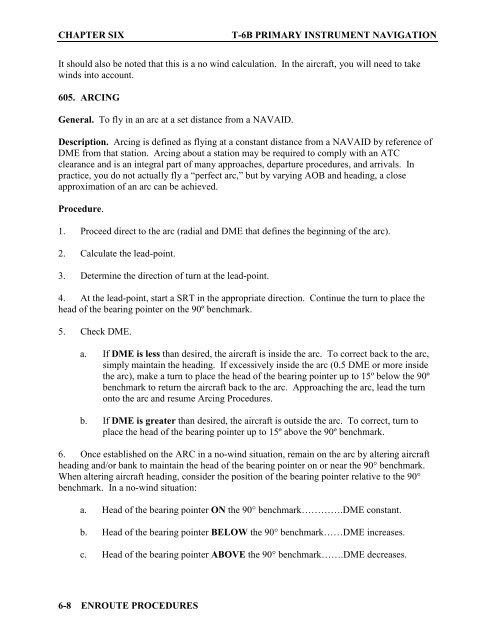Flight Training Instruction - Cnatra - U.S. Navy
Flight Training Instruction - Cnatra - U.S. Navy
Flight Training Instruction - Cnatra - U.S. Navy
Create successful ePaper yourself
Turn your PDF publications into a flip-book with our unique Google optimized e-Paper software.
CHAPTER SIX T-6B PRIMARY INSTRUMENT NAVIGATION<br />
It should also be noted that this is a no wind calculation. In the aircraft, you will need to take<br />
winds into account.<br />
605. ARCING<br />
General. To fly in an arc at a set distance from a NAVAID.<br />
Description. Arcing is defined as flying at a constant distance from a NAVAID by reference of<br />
DME from that station. Arcing about a station may be required to comply with an ATC<br />
clearance and is an integral part of many approaches, departure procedures, and arrivals. In<br />
practice, you do not actually fly a “perfect arc,” but by varying AOB and heading, a close<br />
approximation of an arc can be achieved.<br />
Procedure.<br />
1. Proceed direct to the arc (radial and DME that defines the beginning of the arc).<br />
2. Calculate the lead-point.<br />
3. Determine the direction of turn at the lead-point.<br />
4. At the lead-point, start a SRT in the appropriate direction. Continue the turn to place the<br />
head of the bearing pointer on the 90º benchmark.<br />
5. Check DME.<br />
a. If DME is less than desired, the aircraft is inside the arc. To correct back to the arc,<br />
simply maintain the heading. If excessively inside the arc (0.5 DME or more inside<br />
the arc), make a turn to place the head of the bearing pointer up to 15º below the 90º<br />
benchmark to return the aircraft back to the arc. Approaching the arc, lead the turn<br />
onto the arc and resume Arcing Procedures.<br />
b. If DME is greater than desired, the aircraft is outside the arc. To correct, turn to<br />
place the head of the bearing pointer up to 15º above the 90º benchmark.<br />
6. Once established on the ARC in a no-wind situation, remain on the arc by altering aircraft<br />
heading and/or bank to maintain the head of the bearing pointer on or near the 90° benchmark.<br />
When altering aircraft heading, consider the position of the bearing pointer relative to the 90°<br />
benchmark. In a no-wind situation:<br />
a. Head of the bearing pointer ON the 90° benchmark………….DME constant.<br />
b. Head of the bearing pointer BELOW the 90° benchmark……DME increases.<br />
c. Head of the bearing pointer ABOVE the 90° benchmark…….DME decreases.<br />
6-8 ENROUTE PROCEDURES
















